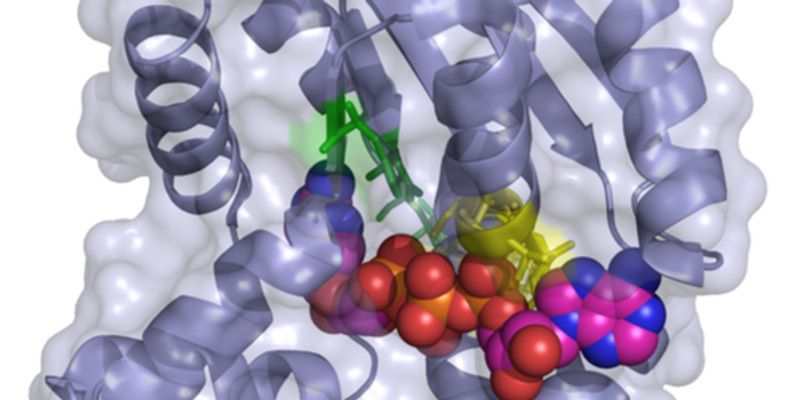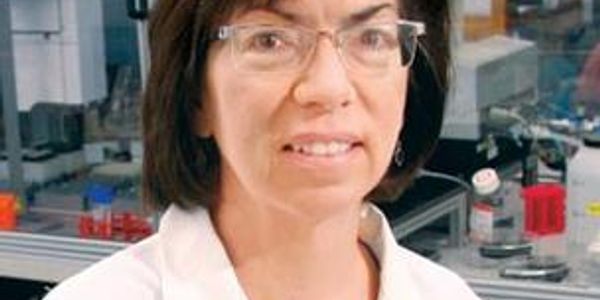Kinases
A kinase is an enzyme that catalyzes the transfer of phosphate groups from high-energy molecule to specific substrates.
-
MAY 12, 2016 | 12:00 PMNetwork models are an invaluable tool for integrating multiple data types and for modeling interactions between biological elements. One common question that arises, however, is what to do wi...MAY 04, 2016 | 7:00 AMLRRK2 is a large (2,527 amino acids) multi-domain protein consisting of 7 putative domains, including a Ras-like GTPase domain called ‘Ras of complex proteins’ (Roc) followed by a...APR 06, 2016 | 6:00 AMThe advent of personalized medicine employing molecular targeted therapies has markedly changed the treatment of cancer in the past 10 years. Although tumor tissue biopsy-based genotyping is...FEB 02, 2016 | 9:00 AMDATE: February 2nd, 2016 TIME: 9am pacific time, 12pm eastern time What is the most appropriate technology to empower your research? Next generation sequencing (NGS) for RN...Speaker: Sridar Chittur, PhD, MBA , Yesim Gökmen-Polar, PhDSponsored By: Affymetrix, AffymetrixJAN 21, 2016 | 8:00 AMDATE: January 21, 2016 TIME: 8am Pacific time, 11am Eastern time In this webinar, you will learn: basics of pooled lentiviral screening workflows implications of ...NOV 04, 2015 | 11:00 AMDATE: November 4th, 2015 TIME: 11:00am Pacific time, 2:00pm Eastern time AMPK, a highly conserved sensor of cellular energy status, is found in all eukaryotic cells and maintains met...JUN 17, 2015 | 8:00 AMDATE: June 17th, 2015TIME: 8am Pacific time, 11am Eastern timeSpatial heterogeneity of tumors has been identified within and between metastatic lesions and can be visualized wit...MAY 13, 2015 | 3:00 PMGenome Wide Association Studies (GWAS) and eQTL analyses are producing huge numbers of associations and show no signs of slowing. There are now more than 8,500 SNPs associated with more than...MAR 18, 2015 | 10:30 AMSchizophrenia is a severe psychiatric disorder affecting 1% of the world’s population, leading to high human, social and economic burdens. Understanding how the interaction of gene and...OCT 30, 2014 | 10:30 AMMany drugs currently used for anti-cancer therapy demonstrate significant inter-individual variability that cannot be normalized using body weight or body surface area. There is an increasing...Speaker: William Clarke, PhD, MBA, DABCCOCT 30, 2014 | 6:00 AMWhen the BCR/ABL1 fusion protein was identified in chronic myelogenous leukemia and the JAK2 V617F mutation was identified in patients with other myeloproliferative neoplasms (MPNs) such as p...Speaker: Kristin Landis-Piwowar, PhD, MLSOCT 29, 2014 | 3:00 PMOver the last decade we have witnessed tremendous advances in our understanding of the underlying molecular alterations in human cancer. This has stimulated excitement for our ability to deve...Speaker: Peter Blume-Jensen, MD, PhDOCT 29, 2014 | 9:00 AMCirculating miRNAs have great potential as biomarkers due to their aberrant expression in cancer and other diseases. However, miRNAs from body fluids are hard to obtain in amounts sufficient...Speaker: Jonathan Shaffer, PhD, MBASEP 16, 2014 | 10:00 AMPatients with chromosomal rearrangements resulting in fusion proteins are among the most responsive to published targeted therapy. For example, targeting of the EML4-ALK fusion in non-small c...Speaker: Sean Eddy, PhDAUG 20, 2014 | 10:45 AMA recent publication in Nature Genetics1 analyzed TCGA data, and classified solid tumors into two mutually exclusive classes: C class tumors, driven by copy number alterations; and M class tu...MAY 29, 2014 | 12:00 PMThe human genome encodes ~21,500 proteins that are subject to reversible phosphorylation at nearly 1 million phosphosites by about 538 protein kinases and 156 protein phosphatases. Amongst ot...Speaker: Steve Pelech, PhDMAR 19, 2014 | 12:00 PMAxonal growth and pathfinding is fundamental to the development and regeneration of the nervous system. Src tyrosine kinase has been implicated in this process; however, the detailed molecula...MAR 19, 2014 | 12:00 PMSynaptic dysfunction and loss caused by age-dependent accumulation of synaptotoxic Amyloid beta (Abeta)1-42 oligomers is proposed to underlie cognitive decline in Alzheimers disease (AD). Syn...MAR 19, 2014 | 10:00 AMNeuron-glial interactions are increasingly recognized as being key for physiological and pathological processes in the central nervous system. Microglia have been found to play a causal role...OCT 17, 2013 | 2:00 PMC.E. CREDITSPancreatic cancer is the 4th most common cause of cancer deaths in the United States. Due to the aggressive nature of this cancer and the lack of biomarkers for early detection, the incidence...Speaker: Antonio T. Baines, PhDOCT 16, 2013 | 3:00 PMC.E. CREDITSDeregulation of ACK1, a non-receptor tyrosine kinase originally identified by its ability to bind to GTP-bound Cdc42 (hence the name: activated Cdc42-associated kinase)(Manser et al., 1993),...Speaker: Henry Chang, PhDOCT 16, 2013 | 2:00 PMC.E. CREDITSNon Small Cell Lung Cancer (NSCLC) is one of the most significant causes of cancer-related mortality worldwide. In about 6-7% of NSCLC, rearrangements involving the Anaplastic Lymphoma Kinase...Speaker: Roberto Chiarle, MDOCT 16, 2013 | 7:00 AMC.E. CREDITSWith the rapid rise in the number of therapeutic options for men with castration-resistant prostate cancer (CRPC) comes increasingly complicated treatment decision-making, emphasizing the nee...Speaker: Andrew Armstrong, MD ScM FACPAUG 21, 2013 | 3:00 PMC.E. CREDITSLong non-coding RNAs (lncRNA) are a novel class of RNA molecule that are emerging as important regulators of gene transcription and post-transcriptional events. lncRNAs have been shown to reg...
MAY 12, 2016 | 12:00 PM
Network models are an invaluable tool for integrating multiple data types and for modeling interactions between biological elements. One common question that arises, however, is what to do wi...
MAY 04, 2016 | 7:00 AM
LRRK2 is a large (2,527 amino acids) multi-domain protein consisting of 7 putative domains, including a Ras-like GTPase domain called ‘Ras of complex proteins’ (Roc) followed by a...
APR 06, 2016 | 6:00 AM
The advent of personalized medicine employing molecular targeted therapies has markedly changed the treatment of cancer in the past 10 years. Although tumor tissue biopsy-based genotyping is...
FEB 02, 2016 | 9:00 AM
DATE: February 2nd, 2016
TIME: 9am pacific time, 12pm eastern time
What is the most appropriate technology to empower your research?
Next generation sequencing (NGS) for RN...
Speaker:
Sridar Chittur, PhD, MBA
, Yesim Gökmen-Polar, PhD
Sponsored By: Affymetrix,
Affymetrix
JAN 21, 2016 | 8:00 AM
DATE: January 21, 2016
TIME: 8am Pacific time, 11am Eastern time
In this webinar, you will learn:
basics of pooled lentiviral screening workflows
implications of ...
NOV 04, 2015 | 11:00 AM
DATE: November 4th, 2015
TIME: 11:00am Pacific time, 2:00pm Eastern time
AMPK, a highly conserved sensor of cellular energy status, is found in all eukaryotic cells and maintains met...
JUN 17, 2015 | 8:00 AM
DATE: June 17th, 2015TIME: 8am Pacific time, 11am Eastern timeSpatial heterogeneity of tumors has been identified within and between metastatic lesions and can be visualized wit...
MAY 13, 2015 | 3:00 PM
Genome Wide Association Studies (GWAS) and eQTL analyses are producing huge numbers of associations and show no signs of slowing. There are now more than 8,500 SNPs associated with more than...
MAR 18, 2015 | 10:30 AM
Schizophrenia is a severe psychiatric disorder affecting 1% of the world’s population, leading to high human, social and economic burdens. Understanding how the interaction of gene and...
OCT 30, 2014 | 10:30 AM
Many drugs currently used for anti-cancer therapy demonstrate significant inter-individual variability that cannot be normalized using body weight or body surface area. There is an increasing...
Speaker:
William Clarke, PhD, MBA, DABCC
OCT 30, 2014 | 6:00 AM
When the BCR/ABL1 fusion protein was identified in chronic myelogenous leukemia and the JAK2 V617F mutation was identified in patients with other myeloproliferative neoplasms (MPNs) such as p...
Speaker:
Kristin Landis-Piwowar, PhD, MLS
OCT 29, 2014 | 3:00 PM
Over the last decade we have witnessed tremendous advances in our understanding of the underlying molecular alterations in human cancer. This has stimulated excitement for our ability to deve...
Speaker:
Peter Blume-Jensen, MD, PhD
OCT 29, 2014 | 9:00 AM
Circulating miRNAs have great potential as biomarkers due to their aberrant expression in cancer and other diseases. However, miRNAs from body fluids are hard to obtain in amounts sufficient...
Speaker:
Jonathan Shaffer, PhD, MBA
SEP 16, 2014 | 10:00 AM
Patients with chromosomal rearrangements resulting in fusion proteins are among the most responsive to published targeted therapy. For example, targeting of the EML4-ALK fusion in non-small c...
Speaker:
Sean Eddy, PhD
AUG 20, 2014 | 10:45 AM
A recent publication in Nature Genetics1 analyzed TCGA data, and classified solid tumors into two mutually exclusive classes: C class tumors, driven by copy number alterations; and M class tu...
MAY 29, 2014 | 12:00 PM
The human genome encodes ~21,500 proteins that are subject to reversible phosphorylation at nearly 1 million phosphosites by about 538 protein kinases and 156 protein phosphatases. Amongst ot...
Speaker:
Steve Pelech, PhD
MAR 19, 2014 | 12:00 PM
Axonal growth and pathfinding is fundamental to the development and regeneration of the nervous system. Src tyrosine kinase has been implicated in this process; however, the detailed molecula...
MAR 19, 2014 | 12:00 PM
Synaptic dysfunction and loss caused by age-dependent accumulation of synaptotoxic Amyloid beta (Abeta)1-42 oligomers is proposed to underlie cognitive decline in Alzheimers disease (AD). Syn...
MAR 19, 2014 | 10:00 AM
Neuron-glial interactions are increasingly recognized as being key for physiological and pathological processes in the central nervous system. Microglia have been found to play a causal role...
OCT 17, 2013 | 2:00 PM
C.E. CREDITS
Pancreatic cancer is the 4th most common cause of cancer deaths in the United States. Due to the aggressive nature of this cancer and the lack of biomarkers for early detection, the incidence...
Speaker:
Antonio T. Baines, PhD
OCT 16, 2013 | 3:00 PM
C.E. CREDITS
Deregulation of ACK1, a non-receptor tyrosine kinase originally identified by its ability to bind to GTP-bound Cdc42 (hence the name: activated Cdc42-associated kinase)(Manser et al., 1993),...
Speaker:
Henry Chang, PhD
OCT 16, 2013 | 2:00 PM
C.E. CREDITS
Non Small Cell Lung Cancer (NSCLC) is one of the most significant causes of cancer-related mortality worldwide. In about 6-7% of NSCLC, rearrangements involving the Anaplastic Lymphoma Kinase...
Speaker:
Roberto Chiarle, MD
OCT 16, 2013 | 7:00 AM
C.E. CREDITS
With the rapid rise in the number of therapeutic options for men with castration-resistant prostate cancer (CRPC) comes increasingly complicated treatment decision-making, emphasizing the nee...
Speaker:
Andrew Armstrong, MD ScM FACP
AUG 21, 2013 | 3:00 PM
C.E. CREDITS
Long non-coding RNAs (lncRNA) are a novel class of RNA molecule that are emerging as important regulators of gene transcription and post-transcriptional events. lncRNAs have been shown to reg...























